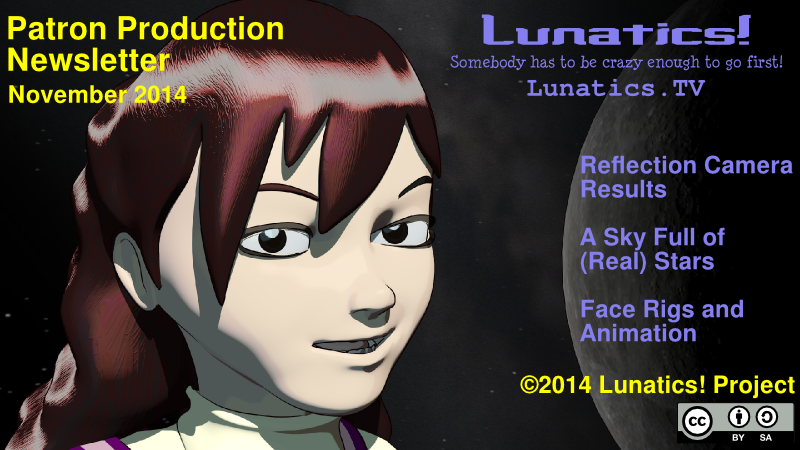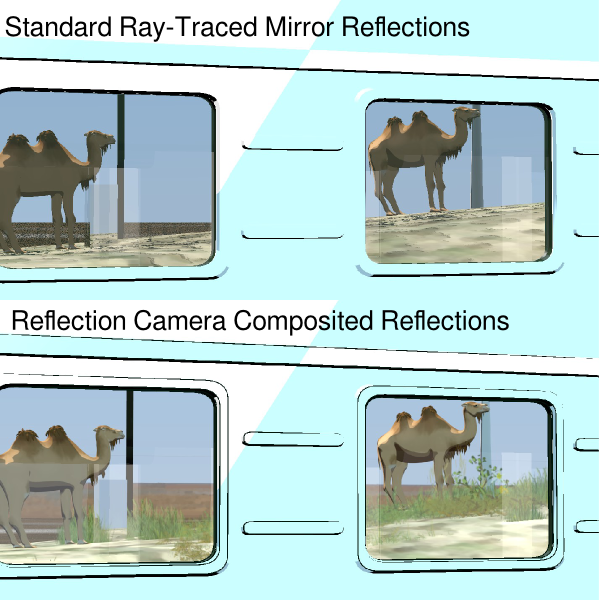Reflection Camera Results
Although we have adopted a non-photorealistic style for Lunatics, we do make a lot of use of lighting and reflections for dramatic effect. This can get very complicated to do well — especially when we want to combine NPR and reflection effects.
Blender includes ray-tracing for reflections, but not all features show up in these reflections. We don’t have a general best-for-all-situations solution for this, but as described in last month’s newsletter, I used two different approaches for reflections appearing in our 01-02-01 Train Exterior shot.
In the October newsletter, I showed you the result of the ray-traced reflector-panel technique used for the reflections on the wheel hubs. And today, I can show you that the reflection camera rig for the window reflections worked perfectly!
As you can see in the image below, the alignment between the simulated reflection camera reflection and Blender’s ray tracer is extremely close — the only noticeable differences being that that the simulated version includes the billboard plants and the ink lines on the camels:
A Sky Full of (Real) Stars
In a lot of science fiction films, the stars are completely fake — just a random scattering of glowing dots in the background. This didn’t seem quite adequate for Lunatics, where we’re trying to keep everything very real.
Creating a really realistic background of stars is hard to do well, though. We were very fortunate, therefore, to get permission from amateur astronomer Paul Bourke to use his carefully-generated real star projections. These are equirectangular sky maps generated from star catalog data. He describes his own production process in detail on his website.
For performance reasons, we’re using this at a 8192×4096, although he has fields up to 32K x 16K. Here’s a section of the starfield we’re using, showing the constellation of Orion:
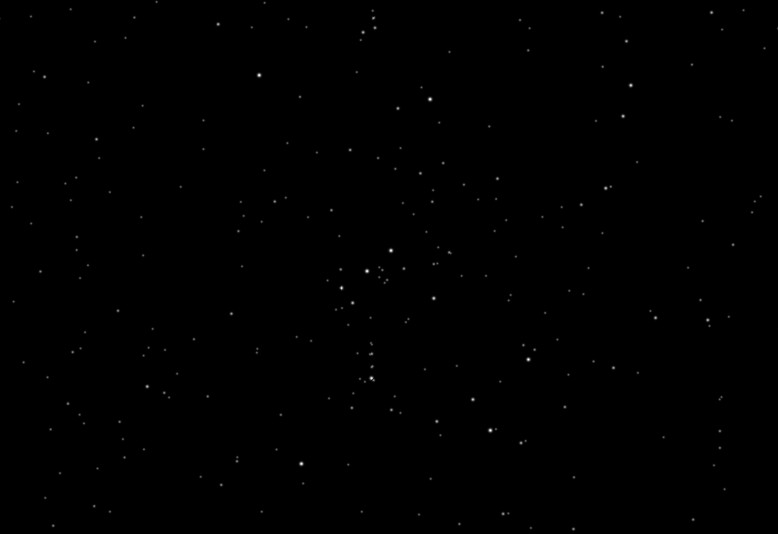
I worked out a number of small kinks with the starfield this month, including switching to a higher-fidelity image and also discovering that I had it flipped upside down (I discovered this while checking to see if the Earth and Moon relationship against the stars was plausible in the opening shot — suddenly everything is a lot more recognizable to this astronomer!).
After working with the shot (01-01-01 Moon to Earth) for quite awhile, I decided I really wanted to be able to see the Milky Way in it. This is a faint nebulosity which comes from the bulk of the stars in our galaxy, which are too far away to be seen individually. Getting this right would take some considerable work.
I tried a lot of different techniques, trying to do this with mathematical precision, but in the end, I came up with an improvised solution that looks pretty convincing, although it’s not rigorously correct.
This was based on two images from Wikipedia. One was a map of the Messier objects, which also includes stars and the Milky Way as an outlined area in an equirectangular projection which matches what we need for a Blender world map. The second was a low-resolution photographic montage of the Milky Way, which unfortunately, was not in a projection I could easily use directly (it would have to be reprojected onto a sphere and then rotated to align correctly with the equatorial coordinates of Bourke’s star field background).
After some fiddling with cartographic software, I finally decided to just “cheat” and used Gimp to rotate and clone portions of the photo montage to match up with the recognizable features on the correctly-projected galaxy from the Wikipedia star map (after eliminating all the other distractions on the map). The result is not perfectly correct, but has the right “look” and matches the location of the galactic center in Sagittarius just about right. As an astronomer, I have only the tiniest twinge of professional guilt over not quite doing it perfectly, but as an artist, I’m extremely happy with the results.
This shot puts the Earth in the context not only of the Sun and Moon, and of the really starry sky, but also frames it against the galactic center, giving a true cosmic perspective.
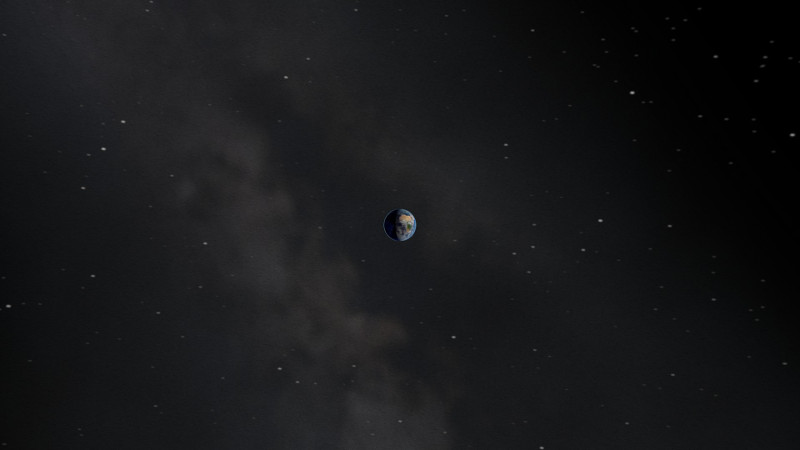
Face Rigs and Animation
Keneisha Perry finished up the face rig for Georgiana, which will become our standard rig for all of our characters, and I (Terry Hancock) finished up the control scripts. I’ve been learning to use it, and have started animating Georgiana’s facial expressions for the final part of shot 01-02-01 (she is seen through the train window, looking at the scenery going by right at the end of this shot).
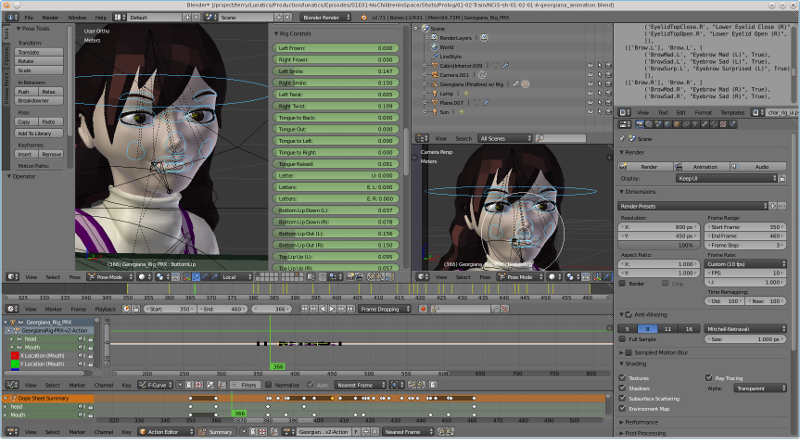
I have hardly any experience animating characters, and we don’t really have an experienced character animator on the project yet, so this is something of a personal challenge. However, I think I’m getting the hang of it. This is a brief test I did in preparing the animation for this shot:
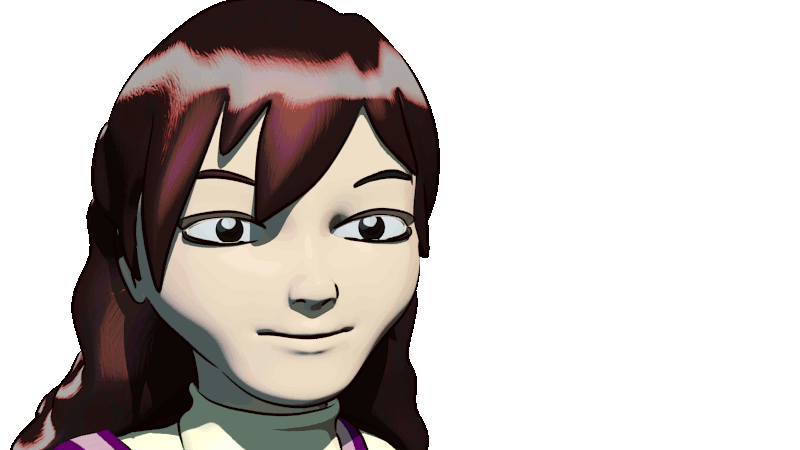
Credits:
| Character Design | Daniel Fu |
| Character Model | Bela Szabo |
| Character Wardrobe Armature Rig & Weight Paint |
Keneisha Perry |
| Textures & Materials Character Animation |
Terry Hancock |
| Set Model | Sathish Kumar |
(Converted from 2014 Patron Newsletter, 2025-10-23)
